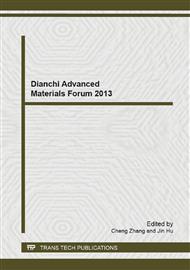[1]
L. E. Cross, Dielectric, Piezoelectric and Ferroelectric Components, Dielectric, Piezoelectric, and Ferroelectric Compoments, Am. Ceram. Soc. Bull. 63(1984)586–590.
Google Scholar
[2]
D. Hennings, M. Klee, and R. Waser, Advanced Dielectrics: Bulk Ceramicsand Thin Films, Adv. Mater. 3(1991)334–440.
DOI: 10.1002/adma.19910030703
Google Scholar
[3]
K. Suzuki, K. Kageyama, H. Takagi, and Y. Sakabe, Fabrication ofMonodispersed Barium Titanate Nanoparticles with Narrow Size Distribution,J. Am. Ceram. Soc. 91 (2008)1721–1724.
DOI: 10.1111/j.1551-2916.2008.02345.x
Google Scholar
[4]
S. Yoon and S. Baik, Formation Mechanisms of Tetragonal Barium TitanateNanoparticles in Alkoxide–Hydroxide Sol-Precipitation Synthesis,J. Am. Ceram. Soc. 89(2006)1816–1821.
DOI: 10.1111/j.1551-2916.2006.01056.x
Google Scholar
[5]
F. Jona and G. Shirane, Ferroelectric Crystals, Pergamon Press, London, (1962).
Google Scholar
[6]
H. Du, S. Wohlrab, M. Wei, and S. Kaskel, Preparation of BaTiO3Nanocrystals Using a Two-Phase Solvothermal Method, J. Mater. Chem. 17(2007)4605–4610.
DOI: 10.1039/b708914g
Google Scholar
[7]
N. Sasirekha, B. Rajesh, and Y. W. Chen, Hydrothermal Synthesis of Barium Titanate: Effect of Titania Precursor andCalcination Temperature on Phase Transition, Ind. Eng. Chem. Res. 47 (2008) 1868–1875.
DOI: 10.1021/ie070986m
Google Scholar
[8]
X. Wei, G. Xu, Z. H. Ren, Y. G. Wang, G. Shen, and G. Hanw, Synthesis of Highly Dispersed Barium Titanate Nanoparticles bya Novel Solvothermal Method, J. Am. Ceram. Soc. 91(2008)315–318.
DOI: 10.1111/j.1551-2916.2007.02098.x
Google Scholar
[9]
Y. B. Mao, S. Banerjee and S. S. Wong, Hydrothermal synthesis of perovskite nanotubes, Chem. Commun. 3 (2003) 408–409.
Google Scholar
[10]
M. Boulosa, S. Guillemet-Fritsch, F. Mathieu, et al., Hydrothermal synthesis of nanosized BaTiO3 powders anddielectric properties of corresponding ceramics, Solid State Ionics 176 (2005) 1301–1309.
DOI: 10.1016/j.ssi.2005.02.024
Google Scholar
[11]
M. Niederberger,G. Garnweitner, N. Pinna and M. Antonietti, Nonaqueous and Halide-Free Route to Crystalline BaTiO3, SrTiO3, and (Ba, Sr)TiO3 Nanoparticles via a MechanismInvolving C-C Bond Formation, J. Am. Chem. Soc. 126(2004)9120–9126.
DOI: 10.1002/chin.200440027
Google Scholar
[12]
M. Niederberger, N. Pinna, J. Polleux, and M. Antonietti, A GeneralSoft-Chemistry Route to Perovskites and Related Materials: Synthesis of BaTiO3, BaZrO3, and LiNO3 Nanoparticles, Angew. Chem. Int. Ed. 43(2004)2270–2273.
DOI: 10.1002/anie.200353300
Google Scholar
[13]
H. Zhang, X. Wang, Z. Tian, C. Zhong, Y. Zhang, C. Sun, and L. Li, Fabrication of Monodispersed 5-nm BaTiO3 Nanocrystals with Narrow SizeDistribution via One-Step Solvothermal RouteJ. Am. Ceram. Soc. 94(2011)3220-3222.
DOI: 10.1111/j.1551-2916.2011.04805.x
Google Scholar


